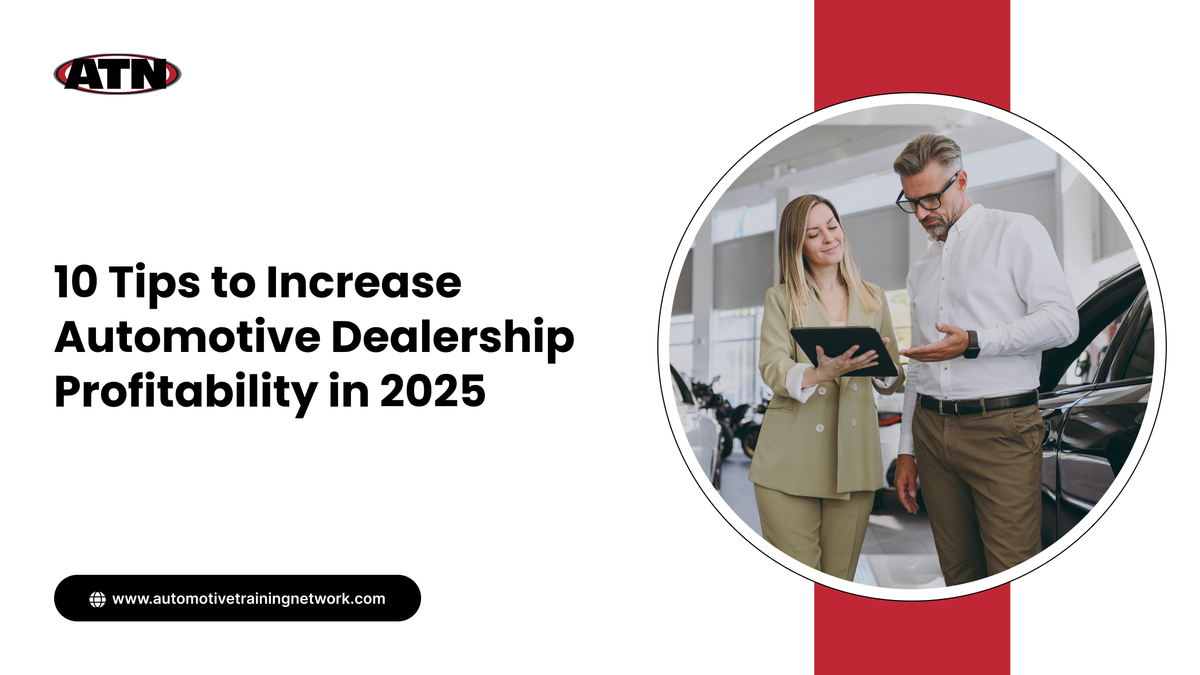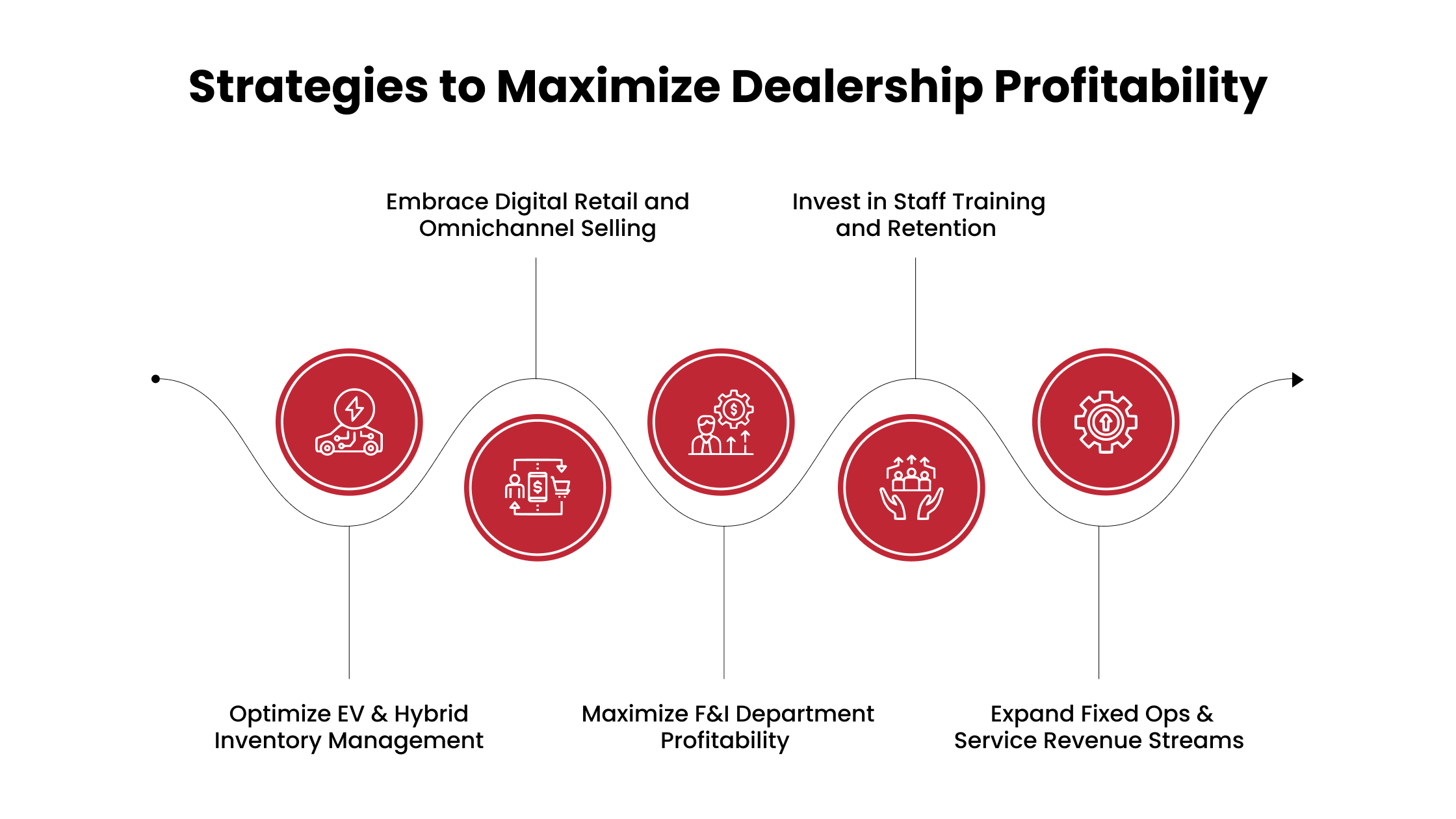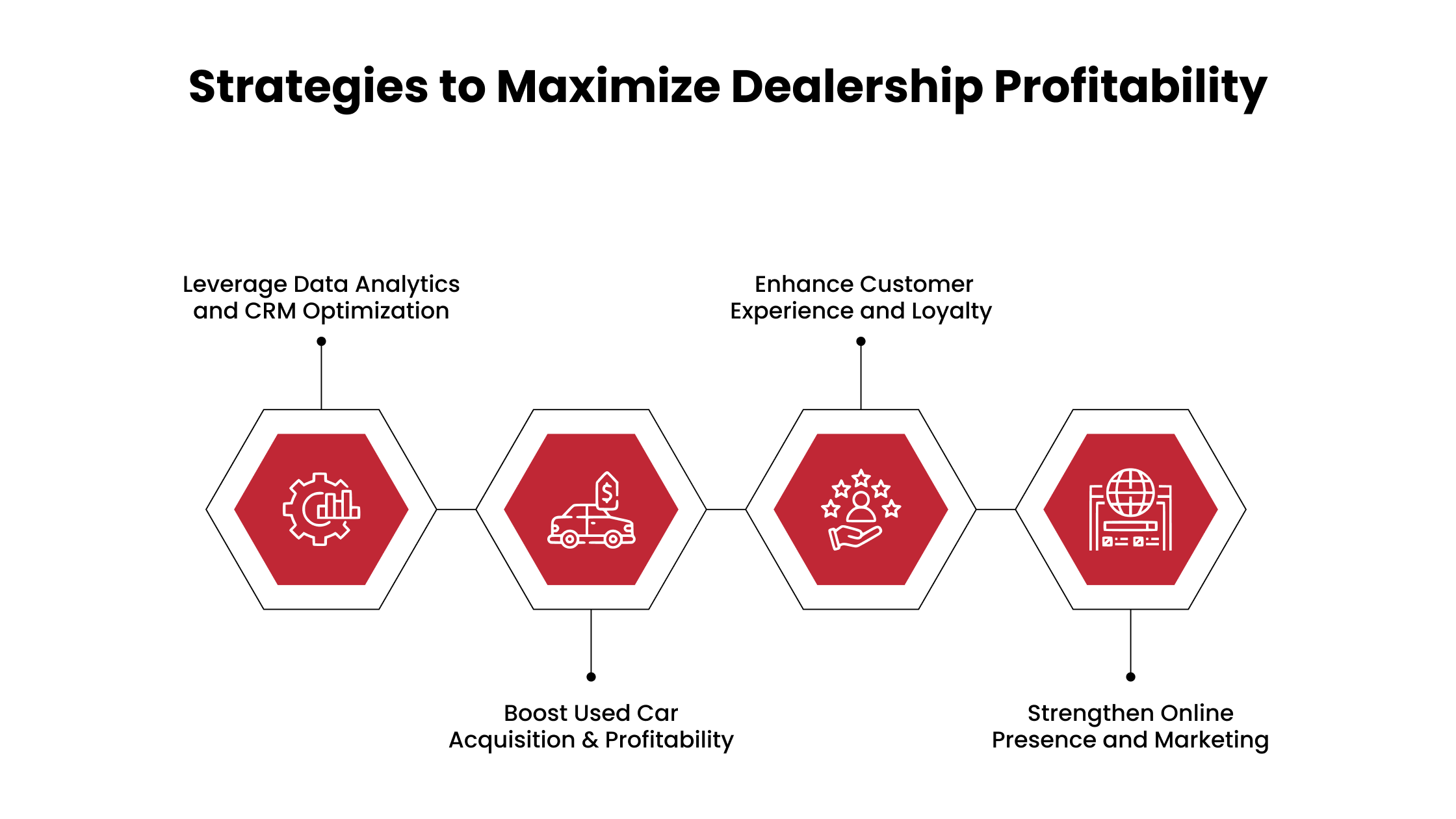10 Tips to Increase Automotive Dealership Profitability in 2025

If your dealership’s performance isn’t quite where you want it to be, then perhaps it’s time for a little boost. The solution may lie in a strategic pivot rather than a complete overhaul. As we move through 2025, the automotive retail industry presents promising opportunities and persistent challenges.
U.S. new-vehicle sales are projected to reach 16.3 million units, with electrified vehicles (EVs and hybrids) accounting for 25% of total sales—a clear sign that the market is evolving quickly. But with progress comes pressure: average gross profit per new vehicle declined by 24.4% in 2024, underscoring the need to refine how dealerships operate. Today’s dealership owners, sales managers, etc, must respond to shifting consumer expectations, navigate the EV revolution, and compete for top-tier talent in a tight labor market to stay ahead.
In this blog, we’re breaking down 10 practical, results-driven strategies to help you enhance profitability in 2025, from utilizing new technologies to aligning every department for greater efficiency and impact.
Strategies to Maximize Dealership Profitability

1. Optimize EV & Hybrid Inventory Management
EV sales are climbing fast. For example, EVs are projected to reach 10% of the U.S. market share in 2025 but don’t move exactly like engine cars. In late 2024, EVs were at 91 days’ supply vs. 79 days for ICE vehicles, meaning unsold EVs can tie up capital.
Actionable Advice: Use data to stock the right mix of EV, hybrid, and conventional models for your region’s demand. Stay on top of federal and state EV incentives and educate your sales team. Furthermore, knowledgeable staff can help customers take advantage of tax credits, making the sale of EVs easier.
Invest in charging infrastructure at your dealership to support EV sales and signal a commitment to EV buyers. Finally, training salespeople on EV product knowledge (battery range, charging times, maintenance needs) will help them confidently address customer questions. By managing EV/hybrid inventory with foresight, you’ll avoid overstocking slow movers while being ready to capitalize on the growing EV wave.
2. Embrace Digital Retail and Omnichannel Selling
Today’s car shoppers expect the convenience of digital retail alongside the in-person experience. Nearly 95% of vehicle buyers use online sources for information, and 43% of recent buyers used an omnichannel approach (combining online and in-store steps). Customers may browse inventory, get financing quotes, or even configure deals from their couch, then visit the showroom only for test drives or delivery.
Actionable Advice: Ensure your website is up-to-date with accurate pricing, financing options, and real-time inventory – essentially a “virtual showroom” for your dealership.
Implement digital retailing tools (credit apps, trade valuations, F&I product menus) that let shoppers start the purchase process online. Enable features like online appointment scheduling and live chat.
Moreover, it’s suggested that data be integrated across channels so that if a customer builds a deal online, your showroom staff can pick up right where they left off. This omnichannel approach reduces friction and appeals to buyers who value speed and transparency. Dealers who embrace digital retailing not only reach more customers but also see higher customer satisfaction.
3. Maximize F&I Department Profitability
The back-end sale of F&I products (warranties, insurance, add-ons) is often more lucrative than the vehicle sale itself. Many dealers “make more profit on the backend” of a deal than on the front end. Crucially, consumers are open to these offerings when presented correctly. 72% of car shoppers want to learn more about F&I products because they see real value.
Actionable Advice: Train your F&I managers to educate rather than hard-sell. Present products transparently, highlighting benefits rather than just cost. Given the 2025 trend toward digital retail, consider introducing F&I options earlier in the online process (through a digital menu or videos) so customers aren’t overwhelmed at the final signing.
Review your F&I metrics, including average profit per vehicle, product penetration, and charge-back rates, and set targets to improve each. Additionally, update your F&I product lineup to reflect new needs. Offering EV battery warranty plans or prepaid maintenance for hybrid systems can tap into the growing EV market. By optimizing your F&I approach and aligning it with customer needs, you boost per-vehicle profitability and enhance customer satisfaction (a win-win that leads to repeat business).
4. Invest in Staff Training and Retention
In a competitive labor market, dealerships nationwide have struggled with high turnover. The annual employee turnover rate at dealerships has been over 46% recently, which disrupts sales and service and incurs significant rehiring costs. In a Cox Automotive survey, 65% of dealership managers said finding and hiring qualified employees is a top challenge. High turnover means lost sales expertise and a poorer customer experience. Conversely, according to the Association for Talent Development, stores that invest in their team see clear benefits – training and development programs can lead to a 24% higher profit margin.
Actionable Advice: Start by fostering a positive work environment with recognition and growth opportunities. Ensure you have a structured onboarding process (employees who go through structured onboarding are far more likely to stay 3+ years).
Implement continuous training – not just one-time orientation. This could mean enrolling staff in workshops from organizations like the Automotive Training Network or hosting weekly skill sessions on product knowledge, CRM usage, etc. Create clear career paths for roles (e.g., junior salesperson to senior to manager) so employees see a future with your dealership.
Consider modern incentives to improve retention, such as performance bonuses, flexible schedules, or profit-sharing. A well-trained, stable team will sell more effectively, give better customer service, and ultimately drive higher profitability through improved performance and customer loyalty.
5. Expand Fixed Ops & Service Revenue Streams
In 2025, fixed ops are crucial to dealership profitability. Historically, the new car department generates ~58% of revenue but only 26% of gross profits, while service and parts (plus used cars and F&I) contribute the majority of profits. With tightening vehicle margins and the rise of EVs, future service revenue must come from new areas. EVs require less routine maintenance (no oil changes or less brake wear), meaning dealerships must adapt.
Actionable Advice: Adjust your service menu for EVs by focusing on high-value services like battery diagnostics, software updates, tire replacements, and brake service. Moreover, you train and certify technicians on EV and hybrid systems to cater to the growing EV market.
For traditional vehicles, increase customer retention by offering free multi-point inspections, competitive maintenance pricing, and convenient scheduling options like online booking or vehicle pick-up/drop-off. Consider offering prepaid maintenance plans or service subscriptions to secure upfront revenue and ensure return visits.
Lastly, don’t overlook parts and accessories sales, like charging station installations or truck accessories, which can significantly boost profits.

6. Leverage Data Analytics and CRM Optimization
In 2025, dealerships that effectively utilize data will gain a competitive edge in profitability, customer retention, and efficiency. Collecting data (leads, web traffic, sales stats, service history) is essential.
Actionable Advice: Connect your CRM, DMS, and other systems for a unified view of each customer and your operations. A complete CRM helps personalize interactions, leading to stronger relationships and higher conversions. Use analytics tools to monitor key real-time metrics, such as inventory turn, gross per unit, F&I penetration, and service RO count. This helps quickly identify issues like aging inventory or declining closing rates. Perform regular data audits to remove duplicates and outdated contacts, ensuring marketing efforts are efficient.
Utilize predictive analytics in dealer software to identify likely purchases or “hot” leads, so your sales team can prioritize them. Ensure your staff logs every customer interaction in the CRM daily. Data-driven decisions will optimize inventory, marketing spend, and sales efforts, ultimately boosting profitability.
7. Boost Used Car Acquisition & Profitability
The used car market remains strong heading into 2025, with retail sales expected to reach 20.1 million units. Many consumers priced out of new cars are turning to used, creating opportunities despite fierce competition and fluctuating market conditions.
Actionable Advice: Focus on smart acquisition by sourcing inventory beyond auctions, such as increasing trade-ins and buying directly from local owners for better margins. Expand your Certified Pre-Owned (CPO) program, especially with OEMs like Honda and Toyota extending CPO eligibility to vehicles up to 10 years old. You may speed up reconditioning processes to get trade-ins front-line ready faster, reducing holding costs. Price used inventory based on real-time market data and adjusted pricing accordingly. Start by weekly monitoring inventory age and wholesale units that aren’t moving to prevent value loss.
8. Enhance Customer Experience and Loyalty
Deliver an exceptional customer experience at every touchpoint to drive repeat business and referrals. You must recognize that loyal customers are valuable, providing steady future revenue at a lower cost than acquiring new customers. You build trust by meeting their needs throughout their car’s life cycle, making them more likely to return and refer others.
Actionable Advice: To build trust and loyalty, prioritize transparency and honesty by providing upfront pricing with clear breakdowns, as many 2025 consumers expect no hidden fees. For service, explain repairs in simple terms and recommend only necessary work. Enhance the customer experience by offering conveniences such as online test drive scheduling, a test drive delivery program, and comfortable waiting areas with free Wi-Fi and coffee.
Implement a loyalty program that rewards service visits with points redeemable for discounts or free services. Follow up with customers after sales or service visits to express gratitude and address concerns. Actively seek feedback through surveys or reviews and show you value their input by acting on it. Empower employees to resolve issues swiftly, turning potential negatives into positive experiences.
9. Strengthen Online Presence and Marketing
Car shoppers are online now more than ever, so your dealership’s virtual presence often makes the first impression. Surveys show twice as many consumers start their research online versus at a dealer, and buyers frequently check reviews and compare websites before ever stepping foot in a showroom. A strong online presence can significantly increase traffic and trust, directly impacting sales.
Actionable Advice: Start by ensuring your website is fast, mobile-friendly, and easy to navigate, showcasing inventory with quality photos, pricing, and financing options. Optimize for local SEO to rank higher in searches like “car dealers near me.” Actively manage your online reputation by claiming and updating your Google My Business profile, responding to reviews, and encouraging positive feedback.
Use social media to humanize your brand with customer delivery photos, community highlights, and informative content. Moreover, Facebook and Instagram can be used for targeted ads and email marketing for personalized offers and service reminders. Track your marketing ROI using analytics to optimize spend and improve results. In 2025, effective digital marketing is essential for keeping your pipeline full and boosting profitability.
10. Embrace Technology and Automation for Efficiency
We recommend modernizing your dealership with the right technology to streamline operations, cut costs, and enhance the customer experience. Today’s dealerships need tech to stay efficient and competitive. Tools like AI-powered marketing, automated kiosks, and digital retail features reduce manual work and meet consumer expectations for convenience.
Actionable Advice: Start by auditing your current software to identify gaps, focusing on integrating a robust Dealer Management System (DMS) and CRM. Implement AI-powered chatbots to handle customer inquiries and schedule appointments around the clock. Streamline operations by automating routine sales tasks like credit checks and trade-in appraisals and service processes like digital check-ins and photo-based vehicle inspections.
Use AI to optimize inventory management and prioritize leads more effectively. Simple upgrades, like e-signature pads, can speed up paperwork and improve customer satisfaction. Most importantly, ensure your team is trained to use these tools to concentrate on building strong customer relationships.
Bottom line: Tech-enabled dealerships operate smarter, faster, and more profitably.
Automotive retail is fast-moving, but only dealerships with the right strategy can turn this change opportunity into a reality. Success relies on adaptability: embracing EVs and digital sales channels, empowering staff, and using data and tech to streamline operations. Prioritizing customer experience across every touchpoint, from online search to service bay, builds loyalty and drives repeat business.
Every department matters. Profits grow exponentially when sales, F&I, service, and marketing sync. The most successful dealerships will stay agile, train their teams well, and refine their processes to meet modern expectations. Start small, act now, and build momentum. 2025 is yours to win with ATN by your side.
Secure Your Dealership’s Future with ATN’s Proven Training

At Automotive Training Network, we understand that succession planning is more than a transition. It’s about safeguarding your dealership’s legacy, maintaining profitability, and building a team that can thrive well into the future. With over 40 years of experience in automotive training, consulting, and management, we’ve helped thousands of dealerships across the globe prepare for what’s next while continuing to grow in the present.
Our comprehensive solutions are designed to strengthen your team, streamline operations, and ensure sustainable success across all departments, from Sales and BDC to Finance and Fixed Ops.
Here’s how ATN helps drive results
- Virtual Training: Engage your team with flexible, customized online sales and service training. Our live coaching sessions are led by seasoned experts who guide your dealership’s current needs and goals.
- 4-Day Bootcamps: Held in Scottsdale, these immersive workshops equip your Sales and BDC teams with the tools, scripts, and strategies to perform at their peak.
- In-Dealership Training: We bring expert instructors to you, delivering hands-on coaching and real-time feedback customized to your team’s strengths, weaknesses, and performance gaps.
- Consulting Services: From financial analysis and executive development to operational improvements, our advisors work with you to align strategy with execution and drive measurable gains.
- Managed Store Services: Whether you run an independent store or a franchise, we can serve as your General Manager, guaranteeing profitability through a hands-on, data-driven approach.
